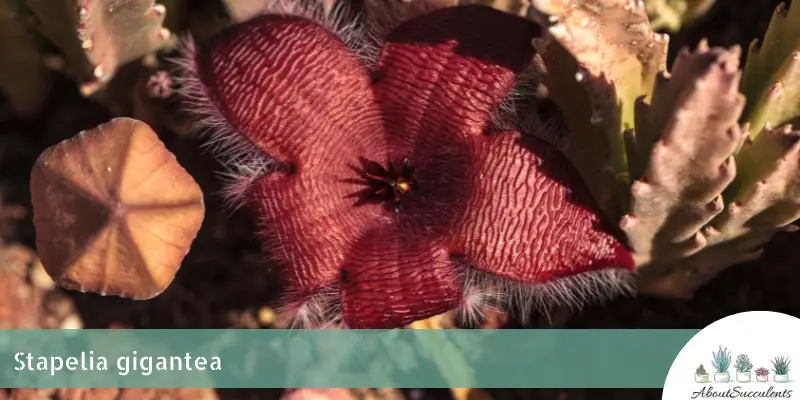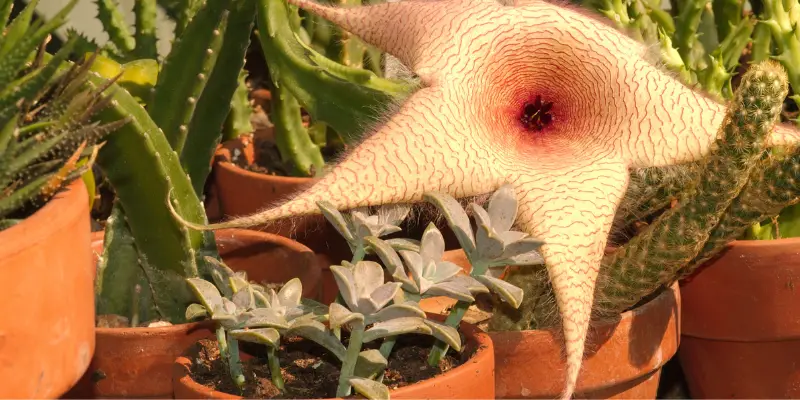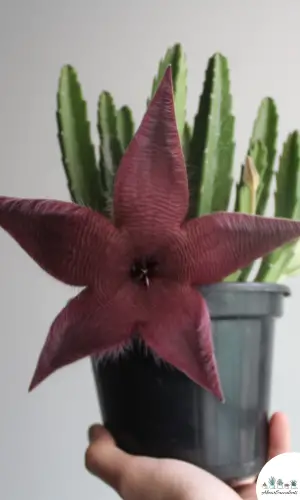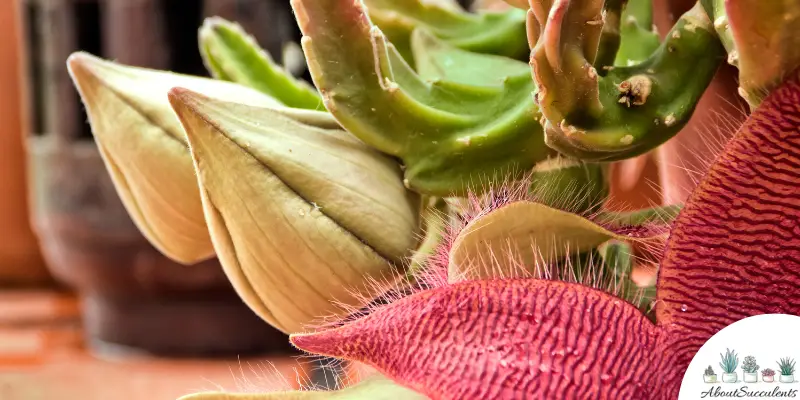
Stapelia Gigantea, also known as “Zulu Giant” and “Starfish Flower”, is a spineless succulent that is well-known for producing the largest and most enchanting flowers in the succulent kingdom.
The 5-petalled, beige-colored, star-shaped flower is distinctly adorned with thin maroon transverse lines. The giant flower blooms up to 7.87 to 15.75-inches (20 to 40cm) in diameter. It has a leathery texture and hairy edges.
Although the plant’s flowers emit a rotten meat scent, it is one of the most sought-after succulents due to their eye-catching appearance. The putrid, spoiled meat-like odor of the flowers has bestowed an unflattering nickname for Stapelia Gigantea – Carrion Flower.
The Zulu Giant flower is beautifully nestled on tubular, fleshy, 4-sided, green stems lined with tubercles or teeth. The spineless stems shoot up to 8-inches (20.32cm) to 12-inches (30.48 cm) tall.
Stapelia Gigantea is native to the arid regions of South Africa and Tanzania. This flowering succulent plant is part of the genus Stapelia of the Apocynaceae family.
General Information
Also known as: Zulu Giant, Carrion Flower, Giant Toad Plant
Plant Family: Apocynaceae
Origin: South Africa and Tanzania
Height: 30.5 cm (12”)
Exposure: Full to Partial Sun
Water Needs: Drought-tolerant; ‘Soak and dry’ watering method
Soil Type: Succulent or cactus soil combined with gritty materials such as sand, fine pumice, or gravel
Soil pH: 5.5 to 6.5
How to Grow and Care for Stapelia Gigantea

Stapelia Gigantea can grow well outdoors with little care. When it is in full bloom, it turns into a breathtaking ground cover for any rock garden. It is best to grow Zulu Giant outdoors due to its unpleasant scent.
However, if you prefer Zulu Giant indoor succulent, place the pot in a well-ventilated to filter out the odor and of course, it must receive sunlight.
Stapelia Gigantea is not frost-hardy and cannot tolerate temperatures below 10 °C (50 °F). If you live in an area where it gets colder than 10 °C, it’s best to pot your succulent so you can move it indoors.
Sunlight
Plant your Zulu Giant in an area where it can get plenty of bright light for at least 6 hours every day. Stapelia Gigantea will do well under partial or full sunlight. Make sure that your succulent does not get exposed to intense midday sun because the stems and flowers get easily sunburnt.
If you are growing your Stapelia Gigantea indoors, place the container near a South-facing window. Insufficient light exposure will cause your plant to etiolate.
When Starfish Flower experiences etiolation, its stems will stretch out as if it’s searching for sunlight. The plant will lose its natural shape because the stems will wither and weaken. Lack of light will also stunt its growth and adversely affect its production of flowers.
Watering

Succulents are prone to root rot which is caused by overwatering and fungus in the soil. Also, if its roots are immersed in moist conditions for a long time, its cells will rupture and leave the succulent exposed to fungal infection.
Like other succulents, Stapelia Gigantea has minimal water needs. You should only water the soil when you’ve tested it for dryness.
To test the soil’s level of dryness, simply insert a stick an inch deep. If the stick feels dry to the touch after you pull it out, prepare to give the soil a thorough drenching.
This testing process is called the “Soak and Dry” method and if you follow it strictly, your succulent will be protected from root rot.
During summer, water your succulent plant once every 7 to 10 days. When the winter season comes, water the soil only when it is already dry and crumbly.
Pot and Soil
Terracotta and ceramic pots are the best containers for succulents. They are made with porous materials that allow proper soil aeration. Use pots with drainage holes to prevent soil waterlogging.
You need to get the right pot size for your succulent to live long and healthy. Get a shallow pot because succulents have shallow roots and do not require too much soil to grow.
Choose a pot that is 10% wider than your plant’s diameter to give it enough room to grow. Lastly, check if the pot has a drain hole that’s needed to filter out excess water.
Because the Zulu Giant is drought-tolerant, it is best to use well-draining soil. Use a succulent soil mix combined with gritty materials such as perlite, coarse sand, gravel, and pumice.
Fertilize your Stapelia Gigantea with a thin water-soluble fertilizer every 15 to 20 days when it is actively growing during summer. Do not fertilize when it is dormant during winter.
How to Propagate Stapelia Gigantea

Stapelia Gigantea can be propagated by using stem cuttings. The best time to propagate is during Spring.
Stem Cuttings Method
Step 1: Gently pull a stem from the base of the plant. You can also use a sterile sharp knife or pair of pruning shears to cut a stem from the mother plant.
Step 2: Leave the stem cutting in a cool, dry, shaded area for a few days or until the cut ends have been calloused over.
Step 3: Plant the stem cutting in a shallow clay pot filled with succulent soil mix combined with pumice, sand, or perlite.
Step 4: Place the pot in an area exposed to filtered sunlight. Lightly mist the soil once a day. Your Zulu Giant should start rooting after 14 days. Once rooted, use the “soak and dry” watering method.
Frequently Asked Questions
Is Stapelia Gigantea Toxic to Cats and Dogs?
Stapelia Gigantea is not listed as toxic to cats and dogs on the website of the American Society for the Prevention of Cruelty to Animals (ASPCA).
Why is My Stapelia Gigantea Dying?
Is your Stapelia Gigantea wilting, turning yellow, or drooping? Do not overlook these symptoms because your plant may die if you do not address the following issues immediately:
Overwatering
Overwatering leads to root rot which can cause irreversible damage to your succulents. It is important to treat your plant as soon as you detect the ill effects of overwatering.
The roots are already water-damaged when the base of your plant becomes mushy, the leaves turn yellow or black, or the stems turn brown and bloated.
Get a sharpened and sterilized knife and cut out the infected portions of the plant in order to stop the infection from spreading. Sanitize the knife after every use with a cotton ball soaked in 70% isopropyl alcohol.
Once you’ve removed the infected section, you will need to repot your Zulu Giant in fresh soil to revive it.
First, remove your plant from the pot. Gently brush off all the soil from the roots. Use a sterile sharp knife or razor blade to cut off mushy brown/black roots.
Leave the plant in a dry shaded area for two to three days. When the roots have dried out completely, replant your Zulu Giant in a pot filled with fresh succulent soil mixed with gritty materials.
Wait four to five days before watering the plant. Drench the soil with water and let it fully dry out in between waterings.
Aside from excessive water feeding, overwatering can also be caused by poor soil quality and the wrong type of pot.
If you do not use fast-draining soil, water will get retained longer and harm the roots. If you use a pot that does not have a drainage hole, the soil will get waterlogged.
Pest Infestation
Stapelia Gigantea is susceptible to mealybug infestation. Make sure to inspect your plant regularly because these sap-sucking pests like to hide in the nook and crannies.
If they are not removed immediately, your plant will get eaten away and the infestation will quickly spread in your garden.
The first thing you have to do is to Isolate the affected plant. Spray 70% isopropyl alcohol or diluted neem oil directly on the mealybugs. Use cotton swabs dipped in alcohol and neem oil to remove the mealybugs in the crevices of the plant.
Spray your plant every day until all the pests are removed. If the soil is infested with mealybugs, spray the soil or pour diluted neem oil into the soil. During treatment, place your pot in a shaded area to prevent sunburn.
Yes. Stapelia Gigantea produces large, 5-petalled, beige flowers with transverse reddish-brown lines during fall. The star-shaped flowers emit a rotten meat smell which attracts flies that aid in pollination.
Last Updated on June 9, 2022 by Sofia Lara